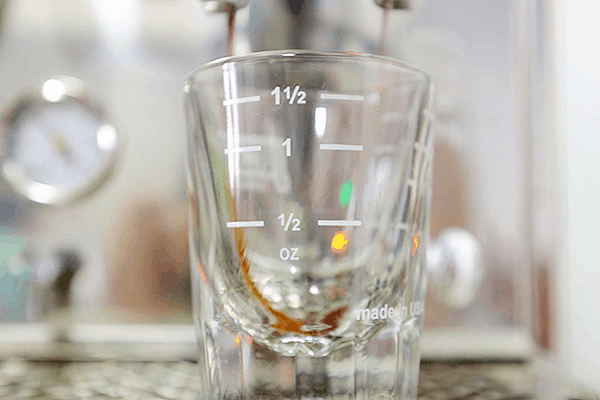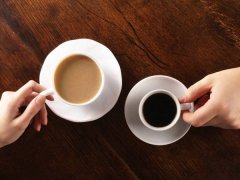How does espresso powder brew itself at home? how to make espresso espresso?

Professional coffee knowledge exchange more coffee bean information please follow the coffee workshop (Wechat official account cafe_style)
Espresso Coffee extraction detailed steps Italian concentration common sense
Italian engineers invented the steam espresso machine at the beginning of the 20th century.
After several evolution, espresso has become an almost unshakable position in today's coffee industry.
From Espresso to Ristretto, from Cappuccino to Mochaccino
And the misunderstood Macchiato....
Just let the old duck talk about it.
Around the mid-1990s, a group of pioneers of Italian cafes appeared in Taiwan.
The only thing familiar to you is Alomaprou Olei.
And then the Norwegian forest La Crema, CIA, and so on.
There was a clear distinction between this batch of Italian coffee shops and many Japanese-style cafes at that time.
Although self-baked beans were not popular in Taiwan at that time
But the rich taste and aroma give Taiwanese who are accustomed to Japanese coffee another choice.
Coupled with the smoothness and ease of import after blending with fresh milk, the consumption of coffee has obviously dropped to young people.
There have been a lot of secrets in the past 20 years.
And many memories of the change of dynasty.
And the Starbucks... whose integration failed in one.
But fortunately, there are many front waves and back waves making continuous efforts for Taiwan's coffee industry.
Taiwan has achieved excellent results in international competitions in recent years.
There is something to be congratulated on--
I don't say much beside the point.
Espresso mainly uses high pressure to extract coffee liquid for a short time.
During the interview and on the Internet, there are many articles saying that it is a big fallacy to "make use of high temperature and high pressure".
As described in the previous chapters
The extraction of coffee falls between 85 and 92.
If you are too high, you will easily have a bitter taste.
This doesn't change because of high pressure.
That's why the earliest invention of steam espresso was improved.
(because the water is converted into steam and the coffee is heated to 100 degrees, the coffee is bitter and grease-free.)
"High pressure" actually means to shorten the time for water to pass through coffee powder.
From coffee classroom 4-grinding and brewing conditions
We have already mentioned the relationship between the brewing time and the thickness of coffee powder.
But under high pressure,
If the pure fine coffee powder is passed by high-pressure and high-speed water
It is conceivable that the coffee powder will be washed into a mess.
In order to control this part,
There is also a "filling and pressing" action in the extraction process of espresso.
1. Fill the ground coffee powder into the "filter" (mostly metal porous filters with diameters 58mm or 52mm)
2. Scrape the coffee powder in the "filter" flat
3. Use the "filler" to exert certain pressure to press the coffee powder into pressed powder.
4. Put "filter" into "handle"
The old duck puts the filter directly in the handle. So.)
5. Turn the "handle" to the "boiling head" and fix it.
6. Turn on the switch to allow hot water to rush through pressed powder under high pressure.
7. Coffee flows out of the diversion port under the handle and is injected into the coffee cup
This is the whole process of making espresso.
It seems very simple.
In fact, a slight difference in each step will lead to a big difference in the final extracted coffee.
Espresso is to enlarge all the flavors.
So the advantages will be magnified and the disadvantages will be amplified.
The difference will also be magnified--
In terms of the thickness of coffee powder
In the world of espresso, the grinding scale can no longer be quantified by the integers of 1, 2, 3.
The turntable of a bean grinder that specializes in grinding espresso does not have a grid.
It's like digital and analogy.
If the turntable is digital, the espresso grinder is like an analogy.
Maybe a little bit will be different--
It is also worth mentioning that
Whether fresh beans are ground or freshly ground
Can be easily judged by the state of the espresso.
So it's important whether the coffee is fresh or freshly ground and boiled.
In the process of filling and pressing
The originally loose coffee powder will be compacted and tight.
It also means that the gap between the powder and the powder will narrow, and the flow channel of the water will become smaller.
The fact that water is not easy to pass means that its pressure can be maintained.
But the same channel size, the same flow rate.
It could be "very fine powder + light filling".
It could also be "fine powder + re-filling".
Although the external flow rate is the same, the degree of extraction is very different--
Therefore, the scale and filling pressure must be considered at the same time when adjusting the taste!
Generally speaking, the pressure of the coffee machine is about 8--9bar.
Coffee can be extracted as long as pressed powder is not compacted enough to resist the pressure of 8--9bar.
In other words, it's possible that the coffee won't flow out--
As long as the powder is fine enough and the pressure is strong enough, it is possible.
Be very careful at this time!
If espresso doesn't flow out or drips slowly,
Be careful to squeeze your hand open under pressure, you may get scalded or drop the handle.
Please pay special attention!
In addition,
When filling and pressing, we should pay special attention to whether the surface of pressed powder is smooth or skewed.
Because high-pressure water will flow to places where it is easy to vent pressure.
So if the surface of pressed powder is not filled and pressed to a flat surface,
It is easy to cause water not to flow evenly across the whole pressed powder.
And extract uneven, astringent and watery coffee--
When general espresso is extracted
About 1oz, that is, about 28--30c.c.
Its flow rate is slow and fine.
Its color is brown with red, called ochre red.
Some are sticky because they are rich in coffee fat (crema).
If you put it in a glass, you can see that espresso will be delaminated quickly.
The bottom layer is dark brown coffee liquid and the top layer is coffee oil with fine bubbles (crema)
Crema will dissipate over time.
The bubble disappears and the oil blends into the coffee liquid.
Generally speaking, we call the time when crema is not dissipated as the best time to drink.
(but it's not so sure.)
To quantify, you can use an ounce cup or a small electronic scale
Now most household coffee machines should be able to set the flow rate.
If not,
It depends on measuring every time or by feeling.
Another way to decide to stop extraction
It is based on experience or color.
Usually in the process of extraction
The color of crema will be lighter and lighter.
From red ochre at first to yellowish brown later
If you turn to a white ivory color, you should stop as soon as possible.
Or even a cup--
There is a situation where the flow rate is normal and beautiful at first.
But suddenly the color changes quickly in the middle, and even flows like a faucet.
Then it is possible that there is a water hole around the pressed powder.
Causes a large amount of water to pass through the water hole to form uneven extraction.
You'd better stop at a time like this as soon as possible.
If you have already extracted half a cup, you can at least drink some.
Otherwise, you'll only drink water, coffee water that is over-extracted--
The water hole may be caused by uneven filling.
It is also possible that there is a gap between the pressed powder and the filter due to knocking or other factors after the filling is completed.
As soon as the high-pressure water comes, it will flow to the big gap.
This is the most important thing to pay attention to when doing filling and pressing!
(the pressed powder knocked out is very important-you can observe whether the extraction is uniform or not.)
A model was proposed by the Italian coffee masterpiece a few years ago.
Is to separate the filter from the handle, fill it with powder, and then put it back into the handle.
The reason is nothing more than
1. Easy to fill and press
two。 Handle and filter temperature
3. Cleaning is not easy
However, in fact, these points can be seen by everyone.
And the temperature is not reasonable.
So use whatever you like--
Espresso also has its own way of drinking--
Because of the small amount of espresso, the temperature is easily affected by the environment and the temperature is cooled rapidly.
In addition to the change in temperature,
At the same time, it will accelerate the dissipation of crema bubbles and lead to a difference in taste.
To avoid this, the espresso cups used by most stores are thick and preheated.
In fact, as long as you master the point of "quick drink", there is no problem of cup selection (of course, preheating is still necessary)
In Italy
It's all done now, and when it's done, people kill it at the bar--
That's for sure
You can drink it in one mouthful or several mouthfuls.
It's just an emphasis on timing--
(riddle: so friends who like coffee to take pictures for a long time don't spend too much time patting without drinking.
It is very important to clean the espresso after brewing!
After removing the handle and bending down to look inside the cooking head, you can find that there are a lot of residual powder attached to it.
At this time, you can press the cooking button again.
The current will take away some of the residual powder.
After the water stops, wipe the inside of the head with a clean and moist dishcloth (please do not wipe the table at the same time)
Such a step can remove 70% of the residual powder.
Those stuck in the grooves need to be cleaned with a special small brush
Usually make coffee at home and clean it thoroughly before turning off the phone.
You don't need to cook a cup, just clear it once--
Finally, after turning off the power,
Remember to release all the steam from the coffee machine to relieve pressure.
So it's done--
.
Important Notice :
前街咖啡 FrontStreet Coffee has moved to new addredd:
FrontStreet Coffee Address: 315,Donghua East Road,GuangZhou
Tel:020 38364473
- Prev

How to drink the most authentic espresso in the top 10 of slimming coffee list?
Professional coffee knowledge exchange more coffee bean information please follow the coffee workshop (Wechat official account cafe_style) Espresso coffee extraction detailed steps of Italian concentrated common sense Single espresso espresso Single espresso is the basic type of kung fu coffee, the quantity is quite small, is one of the most popular coffee in Europe, if you go to a cafe or restaurant to order only
- Next

Semi-automatic espresso coffee machine how to use manual espresso coffee practice skills sharing
Professional coffee knowledge exchange More coffee bean information Please pay attention to coffee workshop (Weixin Official Accounts cafe_style) Espresso coffee extraction detailed steps Italian concentrated common sense ① extraction principle espresso (Italian espresso, also known as Italian espresso) is essentially the use of precision metal filter filtration method, compared with gravity filtration method, the biggest difference is pressure
Related
- What is the Philharmonic pressure? How to use Philharmonic pressure to make delicious coffee
- Why does a hand grinder have more fine powder than an electric grinder?
- In addition to the hot mom, what is the difference between the versions of EK43 | ditting and Mahdi ek43?
- What kind of equipment do you need to make coffee by hand? Introduction to novice starter cooking equipment tools
- Espresso needs to be ground how thick and thin scale entry Italian Coffee Machine Bean Grinder investigation and Grinding course
- How much does it cost to open a small private cafe? How much does it cost to learn coffee? How to operate it?
- The difference between the flavor characteristics of hand-brewed coffee and coffee maker is hand-brewed coffee really better than coffee maker? Can I use a coffee machine to make coffee beans by hand?
- The difference between 01 and 02 of hario v60 filter cup what is the difference between 01 and 02 filter cup opening and cooking flavor
- What's the difference between the smart cup and the French kettle? Which is better, the French kettle or the Smart Cup?
- What's the difference between a smart cup and a V60 filter cup? The difference between the taste of smart cup and hand-brewed coffee

